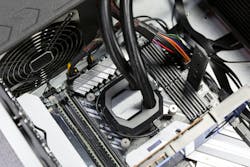The Importance of Liquid Cooling to the Open Compute Project (OCP)
Every day, companies are launching new AI solutions. Finding innovative ways to integrate AI into business operations is top of mind for management across industries. From supply chain management, to research and analysis, to product marketing, AI is growing exponentially as technology improves and key stakeholders grow more comfortable with its use.
As data center managers know, it takes an extreme amount of data processing to deliver the results that users of AI and ML applications have come to expect. The use of high-performance AI chips has pushed the industry towards liquid cooling—a necessity for successfully implementing AI—and hyperscale data centers are preparing to implement liquid cooling on a massive scale.
As hyperscale data centers rush to adopt liquid cooling, the industry must adapt to support these important customers building at scale. A part of this adaptation must be the development of standard cooling solutions that are compatible with a wide range of liquid-enabled racks. This work will help meet growing demand by easing supply chain constraints and improving the reliability of technology around the globe. While many companies have developed proprietary solutions, and will continue to do so, there are also many benefits to greater standardization.
Improving Standardization with the Open Compute Project
The OCP is developing open source design concepts that all manufactures and end-users can contribute to, driving innovation focused on off-the-shelf and easy-to-source solutions within the entire data center space. All OCP solutions are cross-compatible within the OCP universe, meaning they can be rapidly and sustainably deployed at scale.
Since OCP designs are open source, any manufacturer can build the products. The competitive edge for manufacturers comes from using the reference designs to create designs that can be manufactured rapidly at huge scale. OCP’s approach represents a new way of looking at the entire IT ecosystem, from how equipment is deployed, to how it is powered, to how it is cooled.
Earlier this summer, the Open Compute Project (OCP), announced a new initiative to create an Advanced Liquid Cooling solutions project to drive collaboration throughout the industry on these important topics and meet liquid cooling demand.
In a Data Center Frontier article, Bill Carter, chief technology officer of the Open Compute Foundation was quoted saying: “OCP envisions a supply chain offering a variety of IT devices (servers, storage, networking etc.) that can work with a variety of liquid-enabled racks from many solutions providers. . . Direct contact, immersion, and other advanced cooling options are within the scope of this project.”
This OCP initiative is an important project because it supports the growth of liquid cooling, which will benefit data centers, equipment manufacturers and improving sustainability in the industry. However, manufacturers developing OCP solutions and the hyperscale data center projects putting them into use need to remember a few key points:
Look for Complete Solutions
Many manufacturers may begin to offer OCP components, but to take full advantage of the supply and manufacturing advantages of OCP systems, hyperscale and high-performance computing data center managers should work with providers that offer a complete suite of solutions. This includes racks, busbars, CDUs, manifolds and more. Buying different solutions from the same provider enhances the potential supply chain and cost efficiencies enabled by OCP components, as well as the pre-delivery integration that a single-vendor solution can offer.
Local Manufacturing
Data center managers are familiar with the pain of not being able to get the solutions they need when they need them. OCP solutions will be able to be manufactured all around the globe and meet the same standards, so there are more opportunities for equipment manufacturers to produce solutions in the areas where they will eventually be used. Finding partners who can offer local manufacturing is key.
Interoperability
OCP components come with the benefit of interoperability. Components adhering to the reference design specifications means that there will be component interoperability across vendors. This further enhances the value of the OCP ecosystem and can minimize supply chain strain by allowing OCP components to be sourced from a wider variety of vendors.
Conclusion
OCP has the potential to ease supply chain constraints by offering standardization in construction of racks, facility and rack manifolds, connectors, hoses and more. This also has the potential to ease pressure on companies outside of North America shipping to the U.S., reducing carbon emissions from shipping and reducing costs for end users. The efficiencies will also help manufacturers reduce chassis cost, which can also reduce costs for data center managers and planners.
It is often said in the data center industry that if something is two years old, it is out of date. This makes the work that OCP is doing even more critical. One company cannot become the sole producer of data center infrastructure without creating a monopoly, but if we as an industry can agree on certain rules and standards to govern the specifications of equipment, it will help the industry as whole succeed.
About the Author

Kevin Roof
Kevin Roof is a Senior Product Manager at nVent, where he leads nVent’s Data Center Solutions product portfolio for liquid cooling and networking equipment. Kevin brings over 6 years of data center infrastructure experience with a focus on developing scalable and sustainable solutions for data centers. Kevin holds a bachelor's degree in Mechanical Engineering from the University of Minnesota.



